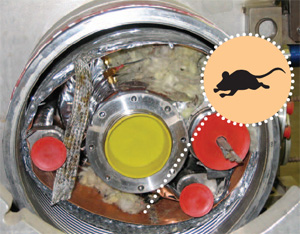 Photo: Jamie Blowers, Fermilab |
The smoking mouse
Because particle physicists cannot directly see the objects they study, they rely on deduction and decay products to detect nature's tiny, ephemeral particles. At Fermilab, for example, scientists use deduction to discover the presence of quarks, leptons, bosons and miceas well as, of course, their anti-particles.
Recently, scientists found evidence for a complex baryonic life form inside a 1200-pound superconducting magnet in Fermilab's Technical Division. Though no one actually saw a mouse, Fermilab Technician Dan Smith uncovered nesting material and bird remnants deep within the "H spool" magnet. According to Smith and other technicians who observed these materials, the nest pieces and chewed bird head contribute direct evidence for the existence of a mouse. However, scientists are still trying to figure out how the mouse got in.
"On the outside of the magnet, there's a stainless steel box," said Smith. "You have to grind off the weld joints to get inside, and there are a good couple miles of welds — literally. Inside there's liquid helium, and then an insulating vacuum. And that's where we found the nest and bird head, which we still have."
Because many types of particles occur only rarely in collisions, it often takes years for physicists to detect new forms of matter. "In the 30 years I've been here," said Smith, "I've never, ever seen something like this."
As for the anti-matter of the mouse, it's actually easier to find than the real matter version. In an unofficial survey, a wide majority of human participants were found to be anti-mice.
Lisa Zyga
Click here to download the pdf version of this article.






